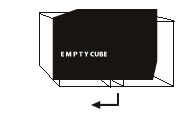JOÃO PAULO SERAFIM
DECEMBER 2015

CONTACTS
joao.p.serafim@gmail.com
EXHIBITION INFORMATION
A Invenção da Memória, 2015
[AIM #2003]
63x83 cm
Inkjet printing on cotton paper
João Paulo Serafim is the fifth artist to be invited by EMPTY CUBE to create a work specifically to be divulged via e-mail. This piece was originally a printed photograph, with the following technical features – A Invenção da Memória [AIM #2003], 2015, 63x83 cm, inkjet print on cotton paper, print run: five numbered copies and two artist's proofs.
The picture the artist has selected for this project is closely connected to a documental, and yet fictional, approach that focuses on filing cabinets (sometimes identifiable), glass showcases containing books and other objects which the artist brings forward as connected to the research he is pursuing at the moment, as well as locations with a certain level of historic and symbolic resonance. His work is bathed in a seemingly romantic aura, as if we were revisiting the times of Friedrich Wilhelm von Humboldt or encyclopedists Diderot and d’Alembert. However, this aura João Paulo Serafim's pictures give off is not held hostage to feelings of nostalgia or loss regarding a particular historic time, being instead a systematic, continuous (re)reading of the notion of archive materials as a leitmotif in the history of ideas and images, a notion that is conveyed to us by the composition and melancholic lighting of the photographs he creates. And this is precisely the case of the work divulged by EMPTY CUBE: it depicts a crate for the transportation of artworks, labelled by the company that produced it and photographed as if it were one of the works it may eventually enclose. But the crate also transcends the aforementioned feeling of melancholy as a metaphor for a container that fulfills its transitory task of preserving, during a journey, a work (or works) destined to be enjoyed by the public. A memory will certainly be left of that journey, a fragmentary memory that is reinvented whenever it is put to use.
In a certain way, this picture is a classic portrait: just look at the central positioning of the figure, at the balanced contrast between light and darkness that lends depth to the background and at the square at the bottom of the cube. Its transitoriness, like the crate itself, is recognisable in the itinerary of this artistic project, in which time moves alongside the spatial geometry that defines the work.
João Silvério
2015
